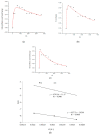Maillard and Hydrolytic Reactions in Subcritical Water Extraction of Bioactive Compounds from Licorice
- PMID: 36296445
- PMCID: PMC9607042
- DOI: 10.3390/molecules27206851
Maillard and Hydrolytic Reactions in Subcritical Water Extraction of Bioactive Compounds from Licorice
Abstract
Nowadays, subcritical water extraction (SWE) techniques are extensively investigated worldwide, while the thermal reactions that inevitably occur under subcritical water conditions are rarely studied. In order to investigate the behaviors of the different reactions during SWE of bioactive compounds from licorice, the Maillard reaction process was accessed via their products and the hydrolytic reaction was analyzed according to the kinetic parameters. In addition, the contents of total phenolics and flavonoids in the extracts obtained at the different temperatures were determined and total antioxidant capacities were evaluated by HPLC-ABTS+. The results showed that flavonoids and phenolics from licorice as well as new compounds generated via the Maillard reaction contributed to the antioxidant activity of the extracts. The fluorescence, color and absorbance of the extracts showed that the degree of the Maillard reaction increased with the rise of the extraction temperature. The kinetics of extraction for glycyrrhizic acid showed that it was firstly extracted by diffusion, and then was hydrolyzed into glycyrrhetinic acid 3-O-mono-β-D-glucuronide and glycyrrhetinic acid following a first-order mechanism. These findings could provide deep insights into the SWE process and a new method for producing glycyrrhetinic acid 3-O-mono-β-D-glucuronide and glycyrrhetinic acid.
Keywords: Maillard reaction; antioxidant; glycyrrhetinic acid; glycyrrhetinic acid 3-O-mono-β-D-glucuronide; glycyrrhizic acid.
Conflict of interest statement
The authors declare no conflict of interest.
Figures











Similar articles
-
The mechanism of hydrothermal hydrolysis for glycyrrhizic acid into glycyrrhetinic acid and glycyrrhetinic acid 3-O-mono-β-D-glucuronide in subcritical water.Food Chem. 2016 Jan 1;190:912-921. doi: 10.1016/j.foodchem.2015.06.039. Epub 2015 Jun 16. Food Chem. 2016. PMID: 26213056
-
Biotransformation of 18 beta-glycyrrhetinic acid by cell suspension cultures of Glycyrrhiza glabra.Phytochemistry. 1990;29(7):2149-52. doi: 10.1016/0031-9422(90)83026-w. Phytochemistry. 1990. PMID: 1366692
-
Extraction of Bioactive Compounds from Pseuderanthemum palatiferum (Nees) Radlk. Using Subcritical Water and Conventional Solvents: A Comparison Study.J Food Sci. 2019 May;84(5):1201-1207. doi: 10.1111/1750-3841.14501. Epub 2019 Apr 3. J Food Sci. 2019. PMID: 30942900
-
Final report on the safety assessment of Glycyrrhetinic Acid, Potassium Glycyrrhetinate, Disodium Succinoyl Glycyrrhetinate, Glyceryl Glycyrrhetinate, Glycyrrhetinyl Stearate, Stearyl Glycyrrhetinate, Glycyrrhizic Acid, Ammonium Glycyrrhizate, Dipotassium Glycyrrhizate, Disodium Glycyrrhizate, Trisodium Glycyrrhizate, Methyl Glycyrrhizate, and Potassium Glycyrrhizinate.Int J Toxicol. 2007;26 Suppl 2:79-112. doi: 10.1080/10915810701351228. Int J Toxicol. 2007. PMID: 17613133 Review.
-
Review of pharmacological effects of Glycyrrhiza sp. and its bioactive compounds.Phytother Res. 2008 Jun;22(6):709-24. doi: 10.1002/ptr.2362. Phytother Res. 2008. PMID: 18446848 Free PMC article. Review.
Cited by
-
Silver Nanoparticles and Glycyrrhiza glabra (Licorice) Root Extract as Modifying Agents of Hydrogels Designed as Innovative Dressings.Int J Mol Sci. 2022 Dec 22;24(1):217. doi: 10.3390/ijms24010217. Int J Mol Sci. 2022. PMID: 36613661 Free PMC article.
References
-
- Baek S.Y., Lee E.H., Oh T.W., Do H.J., Kim K.-Y., Park K.-I., Kim Y.W. Network Pharmacology-Based Approaches of Rheum undulatum Linne and Glycyrriza uralensis Fischer Imply Their Regulation of Liver Failure with Hepatic Encephalopathy in Mice. Biomolecules. 2020;10:437. doi: 10.3390/biom10030437. - DOI - PMC - PubMed
-
- Sánchez-Camargo A.D.P., Pleite N., Herrero M., Cifuentes A., Ibáñez E., Gilbert-Lopez B. New approaches for the selective extraction of bioactive compounds employing bio-based solvents and pressurized green processes. J. Supercrit. Fluids. 2017;128:112–120. doi: 10.1016/j.supflu.2017.05.016. - DOI
-
- Zhang Y., Zhang Y., Taha A.A., Ying Y., Li X., Chen X., Ma C. Subcritical water extraction of bioactive components from ginseng roots (Panax ginseng CA Mey) Ind. Crop. Prod. 2018;117:118–127. doi: 10.1016/j.indcrop.2018.02.079. - DOI
MeSH terms
Substances
LinkOut - more resources
Full Text Sources

